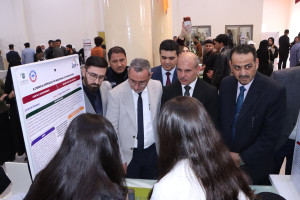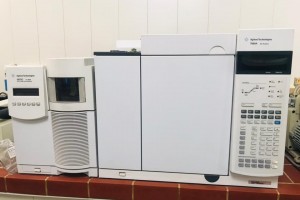
The College of Education for Pure Sciences in the Department of Chemistry at the University of Basrah discussed a master's thesis on (analytical study of some azo dyes and their medical applications)
The message presented by the researcher (Hazem Awad Ali) included
This study includes three main axes:
The first axis :
Three new azo dyes derived from Salbutamol, a basic compound, were prepared with each of Sulfanilamide, Sulfadiazine and Sulfathiazole to prepare dyes HZ1, HZ2, and HZ3, respectively.
These dyes were studied spectrophotometrically, and they were diagnosed using the proton nuclear magnetic resonance (1H NMR) technique, mass spectrometry, and infrared technology (FT-IR). -) that appeared at (1433,1450,1448) cm-1 for dyes (HZ3-Hz2-HZ1), respectively.
As for the spectral study, the maximum wavelengths of the dyes were determined, which are (390) nm for the dyes, and the effect of pH was studied in the electronic absorption spectra of the dyes prepared in the visible region, with a range of wavelengths (550-320) nm for (HZ3-HZ2-HZ1) dyes. By using buffer solutions with different pH values (2-12), and from these spectra, the ionization constant of the hydroxyl group and the constant of the nitrogen atoms of the compounds were calculated using the mid-height method. The isopist points were also determined.
The visible spectra of these dyes were studied with a group of different polar solvents (water) free of ions, ethyl alcohol, chloroform, methanol, acetone, dimethyl formaldehyde) in a range of wavelengths (320-550)0 for dyes (HZ3 - HZ2 - HZ1). Its spectra showed a main absorption band attributed to the transition π → * π in the azo group using different polar solvents, where a linear relationship was found between the maximum wavelengths and the dielectric constants, and this means that the dipole moment is the one that controls the deviation of the peaks bundles.
The second axis:
It included a spectral study of the dye complex (HZ1) with iron, and the color of the complex was greenish yellow at a distance from what the color of the dye was red. The optimal conditions for the formation of the two complexes were determined, including determining the greatest wavelength and it was (390) nm and the effect of pH with a range of buffer solutions ( 12-2) using the bulk buffer solution and its value was (12), using the bulk solution as the best buffer solution. He studied the effect of time from (1-1440) minutes and found no change in the dye absorption values, which indicates its stability to the formed complex, as well as the effect of the succession of addition necessary for spectral studies through which the proportions of the molecular structures of the formed complex are determined depending on the method of molar ratios, and continuous changes The results showed that the complex is formed in a ratio of (1:2) (metal: ligand).
The study also dealt with the applicability of Beer's law and the sensitivity of the spectral method to the azo dye (HZ1) with iron (II) and the values of the molar absorption coefficient (L). mol. 1-cm1- The values of the specific absorbance coefficient (a) ml.gm-1.cm_-1, Sandel sensitivity (S) micro gm.cm-2, the standard deviation values (S.D), and the detection limit (DL) micro .gm.ml- 1.
The third axis:
Some applications of the dye (Hz1) were made, such as measuring the biological activity, where two types of bacteria were used for biological study due to their medical importance and because they cause many diseases, the most important of which are: Escherichia coli. Positive with HZ2 dye.








